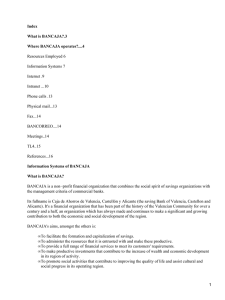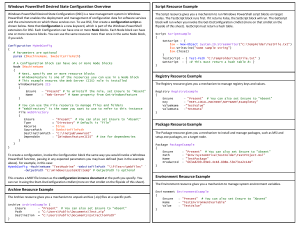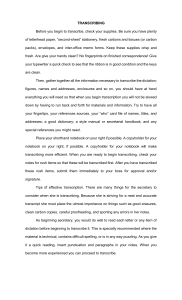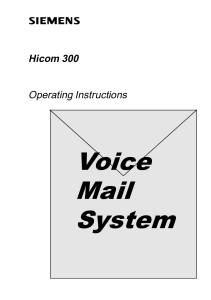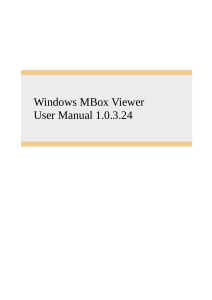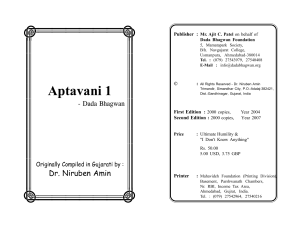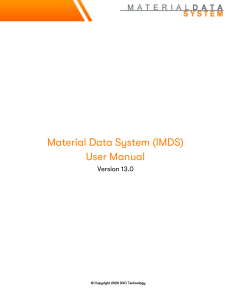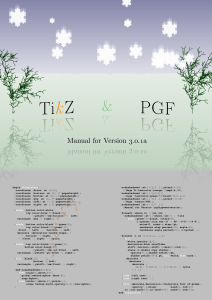Guifi.net: Peer-to-peer network and Free Social
Anuncio
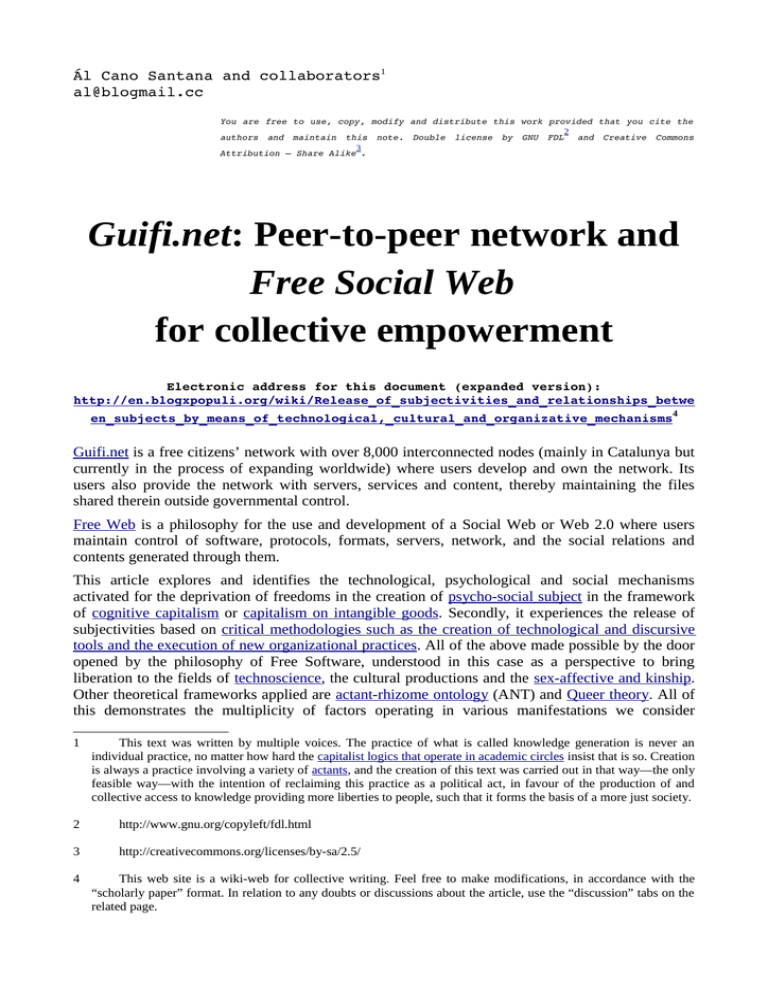
Ál Cano Santana and collaborators1 [email protected] You are free to use, copy, modify and distribute this work provided that you cite the 2 authors and maintain this note. Double license by GNU FDL and Creative Commons 3 Attribution – Share Alike . Guifi.net: Peer-to-peer network and Free Social Web for collective empowerment Electronic address for this document (expanded version): http://en.blogxpopuli.org/wiki/Release_of_subjectivities_and_relationships_betwe 4 en_subjects_by_means_of_technological,_cultural_and_organizative_mechanisms Guifi.net is a free citizens’ network with over 8,000 interconnected nodes (mainly in Catalunya but currently in the process of expanding worldwide) where users develop and own the network. Its users also provide the network with servers, services and content, thereby maintaining the files shared therein outside governmental control. Free Web is a philosophy for the use and development of a Social Web or Web 2.0 where users maintain control of software, protocols, formats, servers, network, and the social relations and contents generated through them. This article explores and identifies the technological, psychological and social mechanisms activated for the deprivation of freedoms in the creation of psycho-social subject in the framework of cognitive capitalism or capitalism on intangible goods. Secondly, it experiences the release of subjectivities based on critical methodologies such as the creation of technological and discursive tools and the execution of new organizational practices. All of the above made possible by the door opened by the philosophy of Free Software, understood in this case as a perspective to bring liberation to the fields of technoscience, the cultural productions and the sex-affective and kinship. Other theoretical frameworks applied are actant-rhizome ontology (ANT) and Queer theory. All of this demonstrates the multiplicity of factors operating in various manifestations we consider 1 This text was written by multiple voices. The practice of what is called knowledge generation is never an individual practice, no matter how hard the capitalist logics that operate in academic circles insist that is so. Creation is always a practice involving a variety of actants, and the creation of this text was carried out in that way—the only feasible way—with the intention of reclaiming this practice as a political act, in favour of the production of and collective access to knowledge providing more liberties to people, such that it forms the basis of a more just society. 2 http://www.gnu.org/copyleft/fdl.html 3 http://creativecommons.org/licenses/by-sa/2.5/ 4 This web site is a wiki-web for collective writing. Feel free to make modifications, in accordance with the “scholarly paper” format. In relation to any doubts or discussions about the article, use the “discussion” tabs on the related page. representative of the phenomenon of taking away liberties: among others, the case of what is known as the Social Web or Web 2.0 and specifically the construction of communication via traditional electronic mail and construction of a network of private communication financed with public monies. The results obtained were the facilitation of a personal and collective process of empowerment and self-enabling, the enrichment of personal and group communication and the creation of accessible knowledge. All have fostered the liberation of public subject positions with the power to carry out political actions. Introduction This study is based on studies related to the free software movement. This is a social movement based on technological development, strongly consolidated worldwide, in operation for over twenty years and which has already achieved its main objective: to create a completely free computer operating system5. This objective falls within another more general goal: to establish an independent moral, political and legal frame of reference as an alternative to the development and distribution of proprietary software, a response to the ideology of taking away the liberties that were operating in the field of software technology in the early 1980s and which have continued in other fields like cultural productions through the 1990s and into the 21st century to date. These ideologies are characterized by the search for economic profit through trading immaterial goods beyond ethics or the social good and through carrying out practices that hinder software development (Stallman, 2004) and that use technology and the law to close down culture and control creativity (Lessig, 2005), among others. This ideology is implicit on many occasions, but a theoretical reference can be found in Bill Gates’ book titled The Path to the Future (1995). From this base, previously studied by other authors, other proposals have arisen based on freedom, which, as a whole, have come to be known as the free culture, free knowledge, or copyleft movement. They have involved a number of studies of technoscientific knowledge that can be classified as “Theories of Free Knowledge” or a “Free Software Perspective”. This is the case of initiatives for the liberation of cultural contents such as Creative Commons (Lessig, 2005), initiatives to create free communication networks such as World Summits on Free Information Infrastructures and their Wireless Commons, proposals to create political and development organizations such as the Plataforma Internacional por el Software y el Conocimiento Libres and its Libre Organización or proposals for the liberation of human relations carried out by the Blogx Populi group and its. These emergent initiatives operate in several social fields such as information and communication technologies, cultural production and collective action and they all work in the field of constructing psychosocial subjects as free or deprived of liberties. In the copyleft movement, this ideology is built on a common base of ethical attitudes and activities related to freedom, collaborative work, the publication of contents, the opening up of its productions and opening toward the new actors involved. The ideology of taking away liberties, however, is built on the imposition of restrictions with proprietary technologies (proprietary software, Digital Restrictions Managers or DRM, private communication networks), laws that control and restrict development (software patents, medication patents, restrictive copyrights, laws against inverse engineering, a royalties tax on private copies, royalty taxes for libraries, laws regulating social organization, organization in political parties, marriage laws, mercantile and corporate laws) and with social norms restricting expression and 5 We mean “free” here as defined by the Free Software Foundation. (Stallman, 2004) communication (patriarchy, family, heterosexual orientation taken as the norm, monogamy, implicit norms that impose restrictions of the personal to the private sphere). This article addresses two of the initiatives carried out with the intention of bringing the liberation of subjectivities to two techno-social areas: telecommunications networks and the social web. Guifi.net and the telecommunications liberation of Guifi.net is a wide area telecommunications network6 comprised by its users. Given the open, inclusive nature of the initiative, it is currently the largest citizen web of webs in the world 7. Also due to its open nature, to become part of the network, one follows its usage licence, Wireless Commons8, based on the GNU GPL free software licence. The researcher has collaborated in technical tests of coverage, in carrying out social chats, configurations, putting actors in contact, etc.; that is why she is part of guifi.net and is recognized as such by the community. Guifi.net is also a space for research and development for the adaptation of technologies to the purposes inherent to an open network. That is why it generates social and technological knowledge and thanks to that structure, the methodological tool was developed enabling the building of technological, cultural and organizational mechanisms which also construct public-political-free subjectivities. Moreover, although guifi.net does not aim to defeat traditional networks, thanks to its critical production it has been able to contribute to un-black-boxing the construct of “telecommunications network”. There is a reason that the phrase for subscribing to news is "Talla els fils que et lliguen" (Cut the cords that bind you). If there is a form of representing the shape of radio waves in a rhizome, it is the new mesh-type network9 we are carrying out in Gràcia (Barcelona), any point of which can connect to any other, wherever it is, with the sole condition that “they can see other”. In this sense, in the course of the research, a proposal was made to structure the concepts of philosophical theory on free networks, dynamic routing technologies, radios and four communities that are involved: Guifi.net, Gràcia Sensefils, Xarxa Sensefils Cooperativa, Freifunk; achieving the constitution of the first node that connects the four networks in the Gràcia area of Barcelona. Creating the Free Network: an integrating node of Guifi.net On 28 April 2008, a meeting was held at the local Infoespai among members of Gràcia SenseFils, Xarxa SenseFils Cooperativa, Guifi.net, Badalona Wireless and the German Freifunk free network. We met after two years of working separately and several months of coordination. Our goals and practices were different. Basically, some were in favour of giving priority to being able to have Internet connections in a cooperative way, and others to developing free networks. Fortunately, all 6 At the time of writing, these lines have over 7,800 nodes, cover 11,000 kilometres in links—which is a large part of Catalunya—and are growing exponentially. 7 http://www.elpais.com/articulo/portada/Noticias/Gurb/red/inalambrica/libre/conecta/23/municipios/elpcibpor/20061 005elpcibpor_2/Tes/ 8 In sum: You are free to use the network for any purpose provided that you do not hinder network functioning or the freedom of other users. You are free to know what the network is like, its components and how it works. You are free to use the network for any kind of communication and disseminate its functioning. By joining the network, you help to extend these freedoms on the same terms. http://guifi.net/en/WCL_EN 9 Mesh topology is a network topology in which each node is connected to one or more of the other nodes. Therefore, it is possible to take messages from one node to another by different routes. If the mesh network is completely connected, there can be no interruptions whatsoever in communications. Each server has its own connections with all the other servers. shared the basis of freedom in telecommunications according to the Wireless Commons licence. The objective was to create a node for the free telecommunications network according to the model of Guifi.net, also making it a special node that would propose the development of dynamic routing protocols. This was done thanks to the help of a guest from Freifunk –a German network characterized by making intensive use of dynamic routing protocols– who is also the main developer of one of those protocols. To build the node, materials from various members were used (main board, radios, antennae, boxes) that were assembled, constituting the node as a whole. The node that was created is located on one of the rooftops in the central Plaza de Sol, in Gràcia (Barcelona) and it brings together the networks of Gràcia SenseFils, Xarxa SenseFils Cooperativa and Guifi.net. This node has the most routing technologies in the area to enable the integration of all the networks involved and facilitates the future development of an automated expansion of the network. The technologies it uses are OLSR, BATMAN and BMX. The node is open and can be accessed through the Internet at this address: 195.160.225.38, on Guifi.net at this address: 10.139.6.70 and in its space in the Gràcia area at a frequency of 2.4GHz, channel 1 and essid ch01.mesh.guifi.net. For the first time, technological integration has made it possible for networks with partially distant goals and methodologies to interconnect to reach points farther away that would not otherwise have been possible. From Web 2.0 to Free Web Historical background of Web 2.0 through a case study of electronic mail In 1971, Ray Tomilson developed what we know today as "e-mail" or "electronic mail". He did so while working at BBN (prior to working at Arpanet), based on the programmes SNDMSG and CYPNET. The former made it possible to send messages to various users within the same machine and the latter made it possible to send messages to other machines. Although his superior said that what he was doing was worthless, by 1973, 75% of the traffic at ARPANET was already electronic mail. Today, this type of message exchange via machines connected in a network in an everyday practice for all Internet users. The socio-political implications of this popular tool are what interested the project BlogMail. We particularly wish to question the logics that have instituted electronic mail as a form of private communication. Along with postal correspondence, telephone calls and face-to-face conversations, e-mail can be considered part of individual communication media. Traditionally, it is assumed that these media put certain individuals into contact with each other (Beneyto, 1973), which distinguishes them from instruments for communication with nuclei previously classified by affiliation or membership ("group or collective communication media", such as presentations in scientific centres or congresses) or to transmit messages in an indirect, unilateral way to an anonymous audience with no discrimination at all ("mass communication", such as lectures with no individualized invitations or political rallies) (Beneyto, 1973). Therefore, electronic mail, like postcards, is private in principle and not made to be brought immediately into the light. An e-mail is written for a sole recipient, or for only a few people, that is, expressly for those to whom it is written, with no intention that it will be read by others who are not explicitly its recipients. We are convinced that this conception is not innocent and denotes a serious limitation to the creative potential of everyday communication. In sum, we understand that the privatization of e-mail takes away political power from the private lives of persons. At first glance, one might believe that the private nature of e-mail is a legacy from postal mail. However, the matter is more complex. Several phenomena have favoured the privatization of these electronic messages. Basically, we would point out four: •The intervention of companies, starting in the 1980s, that hoped to market an offer of access to the Internet and its services. For those entities, it was much more profitable to sell individualized packages in which, for example, electronic mail was shown as a solution for personal use. In addition, public mail also requires a network where it would be published and that is now being sold separately. Companies sell greater power capacity 10 at a higher price, but in general, it does not lead to a rise in costs 11; •The appearance of spam in 1994, which made public dissemination of electronic mail addresses a problematic matter; •The foundation of programmes such as Echelon or Carnivore, that aimed to control populations through surveillance of electronic information; 10 11 Under the name of bandwidth, fixed IPs, and technical matters that give agency to the customer. In fact, for example, servers that maintain dynamic IPs make it most costly to maintain fixed IPs, given that the latter do not require servers. •The systematic goal of discrediting hacking in the media, portraying it as an action aimed at indiscriminate or malicious use of computer services (including e-mail). Each of these phenomena has made it necessary –and imperative, at times- to assure the privacy of electronic mail. To attain higher revenue from the sale of network services, companies have designed and sold e-mail as an individual tool. In addition, to keep from being victims of industrial espionage, massive deliveries of commercial electronic mail, governmental surveillance, or any other curious onlooker, social movements and cyber-rights groups have fought to limit and defend private life in the electronic sphere. However, the scenario around the controversy about privatizing information on the Internet would not be complete without examining the other side of the coin. These initiatives are antagonistic: they directly or indirectly confront governmental, commercial and individual surveillance systems. Nonetheless, they are not concerned with questioning the logic that underlies said controversy. They leave intact the production models for information, wealth and subjectivity in contemporary society. Various groups interested in making information circulate freely have been working on this issue. A paradigmatic example is the work done by contra-information groups such as Indymedia, Pangea, SinDominio and Nodo50 . These networks of activists and journalists foster the greater visibility of the agendas, activities and achievements of social movements, especially in what has come to be known as the anti-globalization or “Another World is Possible” movement. Basically, however, they are opposed to the centralization of media at the global level and its centralized, uni-directional communication model, as well as its ties to established power and its economic interests. However, in spite of the significance of their work related to “free speech”, counter-information groups do not see the existence of “private life” on the Internet as a problem. Other experiences do point in that direction. They are related to hacker ethics (Himanen, 2001) and their knowledge production model, which operates based on cooperative technical action and the free distribution of their products via the network. Free software communities are a clear example of this matter. BlogMail is one of these experiences. What we propose here is to carry out a public electronic mail service. We are going to perform in a sort of activist ethnography to change the electronic mail creation tool to one that allows us to carry out the social change we want to take place, and design and build the technological and/or social tools that will foster this change. To do so, we put together the Blogx Populi research, intervention and social engineering group. For us, the existence of a “private sphere” on the Internet is a symptom of how far the limitation of liberties has gone in contemporary society. The distinction between public and private information has political implications that cannot be ignored. The root of the word “private” comes from Ancient Greek: it means “to be deprived of politics”. More recently, various authors have returned to this matter and have stated the following: 'What is private life deprived of? Simply, of life, which is cruelly absent. People are as deprived of communication and self-realization as possible. One should say: of making their own personal history. ' (Debord, 1961, p. 45) 'Proprietary software keeps users in a state of division and impotence. Division because each user is forbidden to help others, or distribute copies; and impotence because users do not have the opportunity to change the programme or find out what it does. ' (Stallman, 2004, p. 78) Based on the above, we affirm that the production and distribution of “private” information has a political nature that has been expelled from the private sphere. Thus, only collective or mass exchanges can have political power. Currently, the personal is relegated to the private sphere. It is an attempt to “deprive” it of political power but, as feminist Lesbians used to say in the 1970s, “The personal is political”12. For the liberation of software and services that support the social web Much has been said since 2004 when O'Reilly presented an article about novelties arising at that time in the world of the Internet related to the constant exchange of content based on social relations. What is known as the social Web or the much more commercial name of Web 2.0 began to be used to refer to all the services which mainly used the Web as the main interface and were based on participatory and/or dynamic Web sites. The title of O'Reilly’s article pointed in a commercial direction: What Is Web 2.0. Design Patterns and Business Models for the Next Generation of Software, and presented Web 2.0 to refer to a second generation of the Web based on communities of users and special range of services, such as social networks, blogs, wikis and folksonomies. According to O'Reilly, Web 2.0 fosters collaboration and the agile exchange of information among the people who use it. In contrast, voices against the new denomination argued that it was simply a commercial strategy to publicize certain companies and not an in-depth study of the reality of the Internet and that no qualitative leap had been taken in Web space. What is certain is that change was gradual and around 2004 most services were based on what is now called a Web 1.0 structure: that is, infrequently updated, static web pages that did not allow interaction with users. Whether a reality or the result of O’Reilly’s article and lectures and the millions of people who coined the term (an Internet search of “Web 2.0” gets millions of hits), it is certain that in the socalled first world we use information and communication technologies to carry out our social relations. Call it Web 2.0, call it the Social Web, call it whatever you want. Nowadays, we read information on the web written by users like us and we can collaborate, correct or subscribe to them. The fixed text and images of Web 1.0 have been expanded to include audio and video, Web sites that are updated without having to be reloaded, maps in motion… and it serves as a cultural and artistic platform for millions of photographers, video artists, musicians and artists of all kinds worldwide who find that Web 2.0 offers them a platform for making themselves known, where they can interact with what was formerly known as “the public” and has now become constant feedback. The gateway to social communication on the Internet was opened by electronic mail in 1971. It was followed by chats and forums, first of all, and then a huge number of instant messaging and IP telephone communications services. With the advent of the so-called Web 2.0 came blogs, video on demand, wikis, and radio stations. Some of these services are free (as in freedom), such as the 12 It is not possible to attribute this sentence to a sole author. By the late 1940s, there were already theoretical productions that refer to this matter but during the 1970s, a multitude of texts appeared, especially following the 1969 publication of Carol Hanisch’s essay titled "The personal is political" in the Redstockings collection titled "Feminist Revolution". In the essay, discussing her experience with women’s groups for over a year in New York and Gainesville, Hanisch stated: "One of the first things we discover in these groups is that personal problems are political problems. There are no personal solutions at this time". Hanisch’s original text can be found at: http://scholar.alexanderstreet.com/download/attachments/2259/Personal+Is+Pol.pdf extremely popular Wikipedia and Menéame, as well as others that are not as popular. However, many popular services are based on proprietary software (see Web 2.0 table). The title of O'Reilly’s article actually refers to the next software generation; it was not solely about Internet services over the Web. Therefore, it is clear that the business model is based on offering a direct service on the software, not the software itself, or even a software license. The software exists and serves as the basis of Web 2.0. O'Reilly’s article is also about the eminently social nature of services related to software. We will discuss each point separately. Web interface Initially, social communication handled by cybernetic networks was multi-protocol in nature; that is, one could access it in multiple ways. For example, electronic mail has a variety of communication protocols (SMTP, POP, IMAP), with communication via the Web (Web mail) only one of these options, developed some time later. At present, the fact that the majority of these services offer their sole communication interface via the Web has the advantage of making them accessible from any computer with a Web client, but the underlying drawback is that the user has no control over the software that is executed on a remote machine from which the user receives only the processed html, losing not only the source code of the programme with which the user is interacting but also access to the binary code. The social nature of software Projects like Wikipedia have proved that the best way to build knowledge is when it is carried out collectively. Projects such as delicious or delirious show that the World Wide Web can be categorized, provided someone is willing to do. This Web classification and indexing model is called the folksonomies model, which requires constant participation from its users. In what some voices are calling Web 3.0, this will no longer be the case, as the model to be adopted is based on folksonomies. It is what is called the Semantic Web. That is, until an automated classification becomes feasible technologically, the community of users will have to carry out that task, without being paid for it. Some have started to say that this is abusive. Problems with using proprietary software on Web 2.0 The problem is that a large percentage of social web services are built on proprietary software, where users must grant rights to the contents produced to use the service, and are excluded from participation in the organization that manages the service. Users must use proprietary protocols and formats owned by the organization that manages the service and depend on a proprietary network. Consequently, large corporations maintain control of a large quantity of personal information as well as the social relations and links established on the web. • • • • • Censorship on Flickr Reappropriation of copyright by MySpace Political censorship on YouTube Google reads your e-mail for advertising purposes Worms attack users of Facebook and Myspace Conclusions Personal and collective empowerment and selfenabling We found that personal and collective empowerment and self-enabling is related to our research subject. Members of the community (no longer called users, given that they have come to form part of the managing group) acquired information technology and telecommunications engineering knowledge as a result of the following: being able to use technological and communication tools that free up communication, private life and the organization of sexual-affective matters; making these tools accessible as free software tools; the use of the blogmail.cc and guifi.net free web portals, which use only free software, with access to the contents, organization, protocols, and the network; facilitating access to technical sources, such as the source code, configuration files, and manuals. The members of the various projects considered the tools as their own and developed information technology abilities that were not in keeping with their former position as subjects. These abilities have also been useful to them in other areas of their lives. This empowerment of users took place not only in the acquisition of technical knowledge; users also obtained the possibility of sharing knowledge of a variety of subjects, including some traditionally relegated to the private sphere such as sexual practices or the organization of relatives not based on the biological family. Access to this knowledge has made us take it into account for our own practices. Enrichment of personal and group communication An additional result was the enrichment of personal and group communication, not only through the socialization of the projects at various presentations at congresses but also directly, given that it fostered physical group communication as it brought issues that had been relegated exclusively to the private sphere into the physical world, the broader social field, and the fields where the communication actually took place (cyberspace, for electronic mail; the Web, for guifi.net; polyamorous communities, for codes for sexual-affective relations). This unexpected result has not only brought knowledge, interactions and their agency to the public; the public has also filled the place where the contents were being produced and/or discussed. Enabling access in cyberspace to sources of public knowledge to masses of people meant that this knowledge reaches public space in everyday interactions. For example: From a reader of mailblogs to a person who has a public electronic mail account: "Felicities, I read the email the university sent you that says they have given you your degree." Or from a person who has a public email account to a regular reader of mailblogs: "I haven’t had time to read my mail the last few days. Have I received any urgent mail?" And the answer: "Yes, they’ve responded to the bureaucratic matter you are waiting to hear about.” Empowered knowledge subject positions and accessible The conclusions from all of these projects are that all these interactions, productions, acquisition of knowledge and political empowerment have not taken place in the use of the proprietary communication tools offered by Yahoo! or Microsoft, nor do we foresee that they will take place in the new creation of the EMD Valldoreix proprietary wireless telecommunications network (just as they have not taken place so far based on the proprietary telecommunications networks in existence to date) and they do not take place in persons on the lower level of the hierarchy of current sexualaffective relations. In fact, these interactions, productions, acquisition of knowledge and political empowerment become impossible to practice and even unthinkable. Work based on proprietary technology turns users into passive subjects with no possibility of experiencing practices, nor even the chance to think of them. This deprivation is much clearer for subjectivities as they are enrolled in new projects, which they have expressed in the following terms: For example, taken from the field diary related to telecommunications networks: "I signed up for Internet at home with Telefónica[...], every day, the connection wouldn’t work, I’d call them on the phone, they wouldn’t fix the problem and there was nothing I could do. Now that I’m in the guifi.net project, when the connection breaks down, I locate what needs to be fixed myself –a router usually has to be restarted-- and it usually takes me only five minutes. [...] I do it with the free software tools the community made available and which helped me learn how the network I use works". The initiatives are independent of each other. Each project works to attain its own objectives in a specific field. Although they all work for a general goal related to freedom, they do not attempt to meet their goals through each other. Even in public presentations of guifi.net, the term "germà gran" (older brother) is used for the Free Software movement and links to free hardware and open standards are developed. Adherence to them is a choice to show affiliation but not a requirement, as is adhering to the norms of the “Wireless Commons” license. In practice, these links are made to a great extent but not entirely. The analysis of this practice in accordance with our Free Software theoretical framework (Stallman, 2004, p.25) is for the purpose of at least partially pursuing its objectives until it has been completely built. That is, it is considered legitimate to use proprietary tools if they serve to create free tools, provided that there are no free tools to carry out the same task. In any case, this subject is a product of internal tensions and negotiations to find out if some of the tools used are free or not and whether free tools actually exist for carrying out certain tasks.
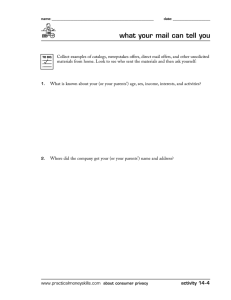
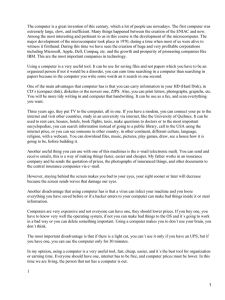
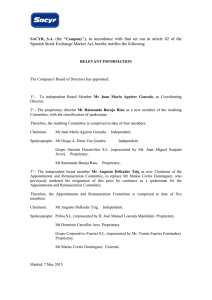
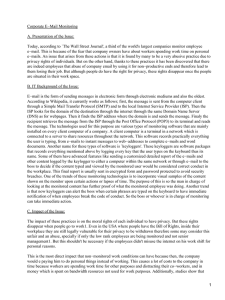
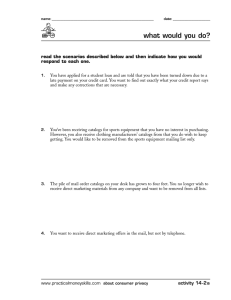
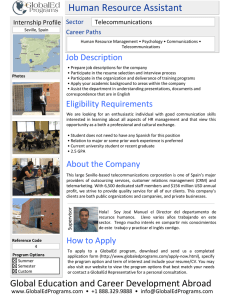
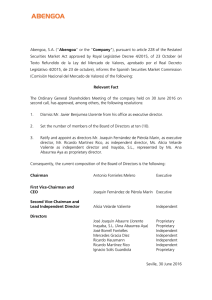
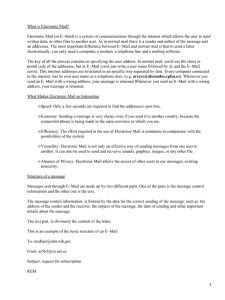
![User`s Guide [NetWork Services] Part1:Early Warning "Area Mail"](http://s2.studylib.es/store/data/006236328_1-a3c5a3ef35138f46acdfaa4977d1d907-300x300.png)
